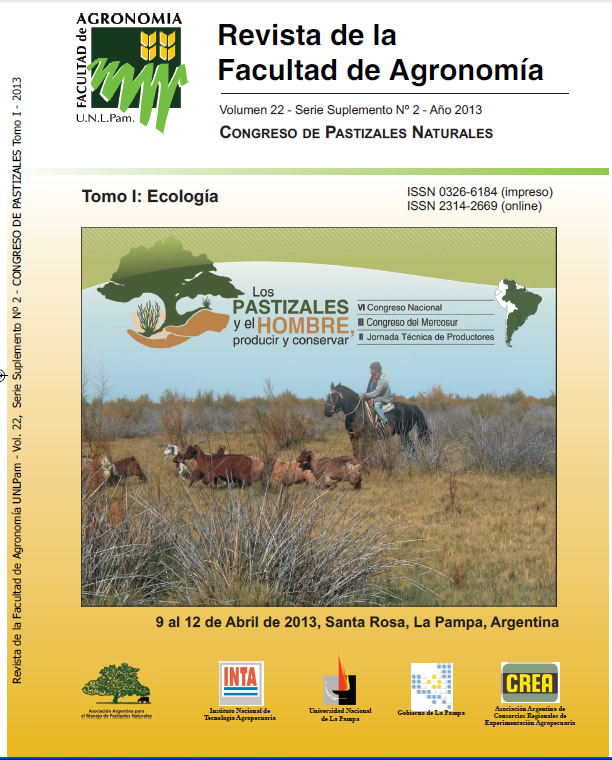Bothriochloa laguroides ssp laguroides (D.C.) Herter biometric characterization, for a sustainable grazing management
Keywords:
Bothriochloa laguroides, Grazing intensity, Grassland hills, South of Córdoba ProvinceAbstract
Grasses morphological knowledge, in space and time, is important in agronomic management actions. Bothriochloa laguroides is a key species in the grasslands of the hills region by higher prevalence of high forage value. The objective was to establish management guidelines to define more precisely the grazing intensity for that species. In a area of 95 ha, grazed breeding farm, were placed randomly distributed 4 closures. In every closing we selected 5 individuals of that species and every 7 days was measured total plant height (AT) and the height of the peduncle of the inflorescence visible (APVI) in both vegetative and reproductive stage. According to the results obtained showed that the growing period was maintained until mid-January. The start, peak and end of flowering occurred in midJanuary, late February - early March and late April respectively. On the other hand, there was a significant positive correlation (R = 0.8, α = 0.05) between AT and APVI. As a result, it could be recommend that grazing in the vegetative stage is of low intensity to favor the formation of bunches. From mid-January, when starts the reproductive stage, grazing may be of greater intensity until early March which should remove the animals. This manage ment would have a large supply of biomass to ensure the perpetuity of the species in time.
Downloads
References
Borrajo C.I., S.I. Alonso, A. Mazzanati & G. Monterubbianesi. 1998. Caracterización de poblaciones naturalizadas de agropiro alargado. Macollaje y caracteres reproductivos. Rev. Arg. Prod. Anim. 18(3-4): 183-192.
Briggs D. & S.M. Walters. 1969. Evolución y variación vegetal. Ediciones Guadarrama, S. A.
Cano E. 1990. Pastizales Naturales de La Pampa. Tomo 1. CREA. Zona semiárida. Convenio AACREA Provincia de La Pampa, Argentina.
Cufre G., O. Forchetti, M. Turelli, J. Alliney, N. Montani & S.D. Andrea. 1987. Plan carencias Minerales XVII Congreso CREA Zona Centro. pp: 41-42; 56-74.
Cufre G., O. Forchetti, M. Turelli, J. Alliney, N. Montani & S.D. Andrea. 1988 Comisión ganadería: Plan Carencias Minerales. Rev. Desde el Potrero 2(9): 14-15.
Deregibus V.A., U. Dol, E.D. Angela, A. Kropfl & A. Fraschina. 1982. Aspectos ecoficiológicos de dos forrajeras estivales de los pastizales de la Depresión del Salado (Bothriochloa laguroides D.C. y Paspalum dilatatum Poir.). Rev. Fac. Agr. de Bs. As. 3(1): 57-74.
Fernández Greco R.C. & R. Viviani. 1991. Guía de reconocimiento de especies de campo natural. INTA-Balcarce. pp. 8.
Gillet M. 1984. Las gramíneas forrajeras. Descripción, funcionamiento, aplicaciones al cultivo de la hierba. Ed. Acribia. Zaragoza, España. Cap. XII. 155-158.
Gimenez D. & C. Rumi. 1984 Evolución del macollaje y ciclo de vida de los macollos en Bromus catharticus (Vahi) “cebadilla criolla”. l Siembra de otoño. Rev. Fac. Agr. de La Plata. 60(1-2): 51-58.
Pagliaricci H. & C. Sarof 2008. Apunte de estudio. Centro de estudiantes de Ingeniería Agronómica.
Perreta M.G., J.C. Tivano & A.C. Vegetti. 2000. Forma de crecimiento en Leptochiloa chloridiformis (Poaceae). Darwiniana 38(3-4): 219-226.
Vega A. 2000. Revisión taxonómica de las especies americanas del género Bothriochloa (Poaceae: Panicoidae: Andropogonae). Darwiniana 38(1-2): 127-186.
Salinas M & C. Silva 2007. Modelos de Re gresión y Correlación II. Regresión Lineal Múltiple. Cienc Trab. 23: 39-41.
Vischi N.B. 1990. Fenómenos fenológicos de la comunidad vegetal del bosque serrano cordobés y su relación con factores ambientales. Tesis. Depto. de Ciencias Naturales, Univ. Nacional de Río Cuarto, Argentina.
Downloads
Published
Issue
Section
License
La Editorial de la Universidad Nacional de La Pampa (EdUNLPam) exigirá a los/as autores/as la firma del siguiente documento:
La EdUNLPam lleva a cabo la publicación del artículo: (Título del Artículo) en SEMIÁRIDA Rev.Fac.Agron UNLPam ISSN 2362-4337 (impresa) ISSN 2408-4077 (en línea), del cual el/los abajo firmantes son autores de una o más partes. En el mismo acto, el/los autores entregan exclusivamente a la EdUNLPam todos sus derechos protegidos por las leyes de propiedad intelectual que rigen en la Argentina para reproducir, publicar, editar, fijar, comunicar y transmitir públicamente en cualquier formato o medio impreso o electrónico, inclusive internet, el artículo enviado a publicación e incluirlo en índices o bases de datos nacionales e internacionales. A cambio, la EdUNLPam entrega a los autores la autorización para la publicación o reimpresión con ines académicos y educativos en cualquier libro o medio de divulgación, con la sola obligación de citar el artículo original publicado en la EdUNLPam. Cada autor acuerda en que el material provisto a la EdUNLPam es un trabajo original, que no ha sido impreso o publicado en cualquier otro medio con anterioridad y que no vulnera derechos de terceros. El Primer autor tendrá la posibilidad de leer y corregir el artículo ya editado como “prueba de galera”, pero si el autor no devolviera esas correcciones de la prueba de galera dentro del tiempo especificado, el proceso de producción y publicación podrá proseguir sin la aprobación del autor. El/los autor/es no recibirán compensación monetaria de la EdUNLPam por el uso del material contenido en este artículo y asumen la responsabilidad de las opiniones vertidas en él.






.png)



22.png)



.jpg)




.jpg)
